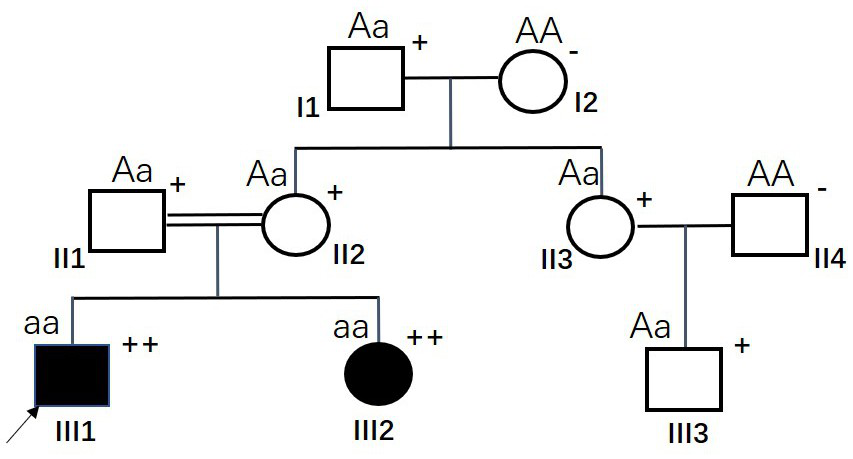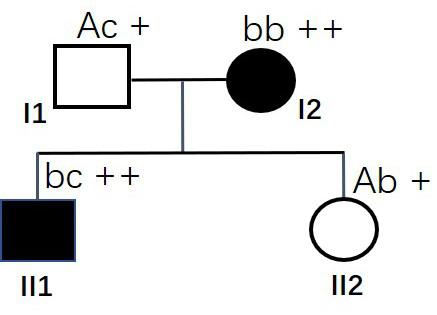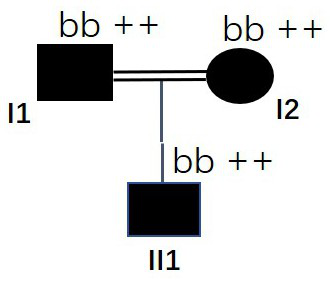A mutated msh6 gene at position 12759 and its application
A technique of mutating genes and genes, applied in the field of new hypophosphatemic rickets pathogenic genes and their detection kits, can solve the problems of no absorption and metabolism research reports
- Summary
- Abstract
- Description
- Claims
- Application Information
AI Technical Summary
Problems solved by technology
Method used
Image
Examples
Embodiment 1
[0020] Example 1 found that the specific MSH6 mutation gene is the pathogenic gene of HR
[0021] figure 1This is the HR family with the earliest MSH6 gene mutation detected (family #1), II1 and II2 are consanguineous marriages (II1 is the only child and the parents have died). Among them, both siblings III1 and III2 showed symptoms of short stature and rickets, as well as hypophosphatemia and increased urinary phosphorus, and were clinically diagnosed as HR. Except for HR, III1 (the proband, marked by the arrow) was diagnosed with stage III colorectal cancer at the age of 24 in 2018. The tumor was surgically removed, but recurrence occurred six months after the operation. Family history investigation revealed that both III1 and III2 in #1 family were HR patients, and III1 was diagnosed with colorectal cancer, which has certain pathogenic genetic indications and tendencies. In order to guide the follow-up treatment of colorectal cancer patient III1, analyze the potential gen...
Embodiment 3
[0044] Embodiment 3 HR population sample verification
[0045] On the basis of Examples 1 and 2, the MSH6 gene mutation was further detected in the HR population. A total of 27 clinically confirmed HR patients (number S1-S27) were collected, including 16 male patients and 11 female patients, aged 26.3 years (4-57 years old). According to the PCR capture sequencing method in Example 1 (Table 1 and Table 2), under the condition of full informed consent of these HR patients, blood samples (peripheral venous anticoagulant blood 2ml) were collected for MSH6 gene mutation detection, the results are shown in Table 5 shown. Among them, only S1-S17 HR patients were detected to contain specific mutations of the MSH6 gene, while none of the S18-S27 HR patients were detected to contain any MSH6 gene mutations, indicating that there are other known or unknown gene mutations that can lead to HR. Occurs (such as the PHEX mutant gene on the X chromosome). In S1-S17 HR patients, only the g....
Embodiment 4
[0052] Application of embodiment 4 specific MSH6 mutant gene
[0053] Such as Figure 8 The family shown (family #7), both husband and wife are normal persons, has given birth to a child with HR, and now plans to have another child and undergo genetic counseling. Whole exome capture sequencing was performed on blood samples collected from the husband and wife and the child with HR, and it was found that the father I1 had the g. [12759inTTAAG] mutation (heterozygous, genotype is Ac), while HR child II1 has MSH6 gene g.[12759inTTAAG] mutation and g.[12907inCAGC] mutation (compound heterozygous mutation, genotype is cd). These two MSH6 gene mutations were inherited from their mother and father respectively; except for the two specific mutations of the MSH6 gene, no other obvious gene mutations were detected in the family members. The phenotype was determined by the genotype in this family, and the phenotype was co-segregated with the genotype. Combined with the results of Examp...
PUM
 Login to View More
Login to View More Abstract
Description
Claims
Application Information
 Login to View More
Login to View More 


